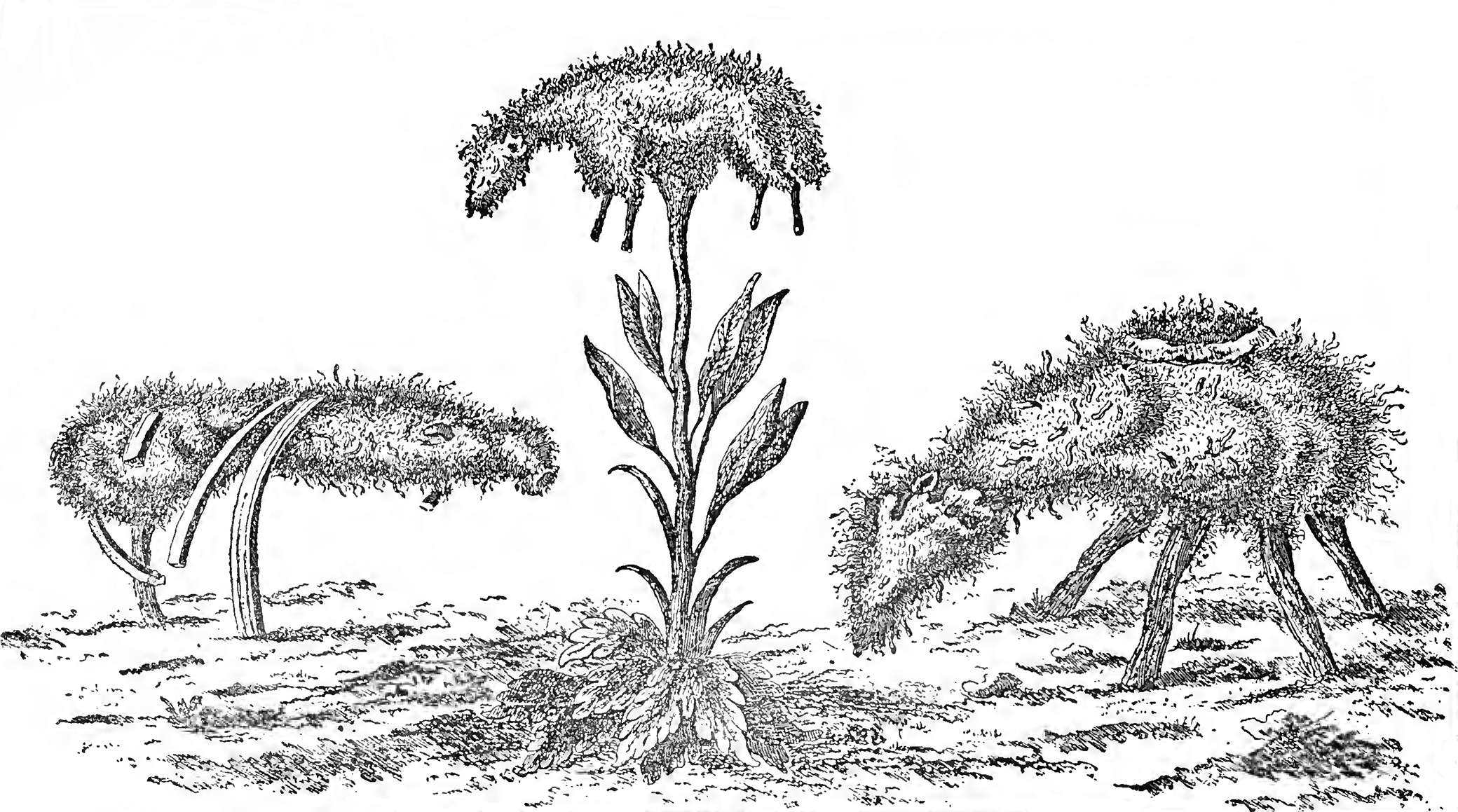
“The ‘Borometz,’ or ‘Scythian Lamb,’ ” from Connubia Florum, by De La Croix, 1791, reproduced in The Vegetable Lamb of Tartary: A Curious Fable of the Cotton Plant, by Henry Lee, 1887. The Internet Archive, University of Toronto.
According to one medieval story, a soft white fleece grows from a green stalk. The plant’s substance yields muscle and blood the way other plants bear fruit. A newborn lamb appears atop the plant. As it matures, the stalk bends toward the ground and the lamb takes its first tentative steps, still attached to the stalk and linked to roots in the ground. Soon it begins to munch the grass, suggesting a cycle of life that runs from plant to animal and back again, all on the same patch of soil. The Vegetable Lamb of Tartary, also called the Scythian Lamb or borometz, was a widespread tale conveying what wonders lay to the East, beyond the confines of late medieval and early modern Europe—the kind of chimeric wonders that seemed to recede as the searching traveler approached. Call the Vegetable Lamb a myth, yet it is still an effort to ask how the world makes sense by contemplating a creation that challenges the way we order things. It allows for a liminal space between the categories of fauna and flora. As late as the 1890s, scholars were still commenting on the Lamb, and while these moderns looked on the legend with skepticism and wrote to debunk it, they were writing about it nonetheless. Generations after scholars stopped writing about the Lamb, it still stands, bleating, for how past generations sutured together the disparate, unfamiliar parts of nature in search of a coherent whole.
It is hard to determine the precise material basis for the Lamb myth, but the creature did not simply spring from the ground and graze upon the credulity of untraveled Europeans. There are descriptions of Indian “tree wool” in Ancient Greek writings that sound a great deal like cotton: Theophrastus wrote about wool-bearing trees observed in the Persian Gulf whose wool grew within pods. He used the word melon to describe the pods, a word meaning both “apple” and “sheep” in Greek. (The late Fordham University classics professor Robert Carrubba speculated that Theophrastus was describing cotton, and that the linguistic association between the two meanings of melon may have eventually contributed to the growth of the myth of the Lamb.) Herodotus wrote, “There are trees that grow wild [in India], the fruit whereof is a wool exceeding in beauty and goodness that of sheep. The natives make their clothes of this tree-wool.” There is even a version of the Vegetable Lamb story in the Jerusalem Talmud, the collection of rabbinic commentaries on the Hebrew Bible compiled around 400. In it one Rabbi Jochanon speaks of a lamblike plant-animal, growing from the ground as if a gourd, whose flesh is sweet.
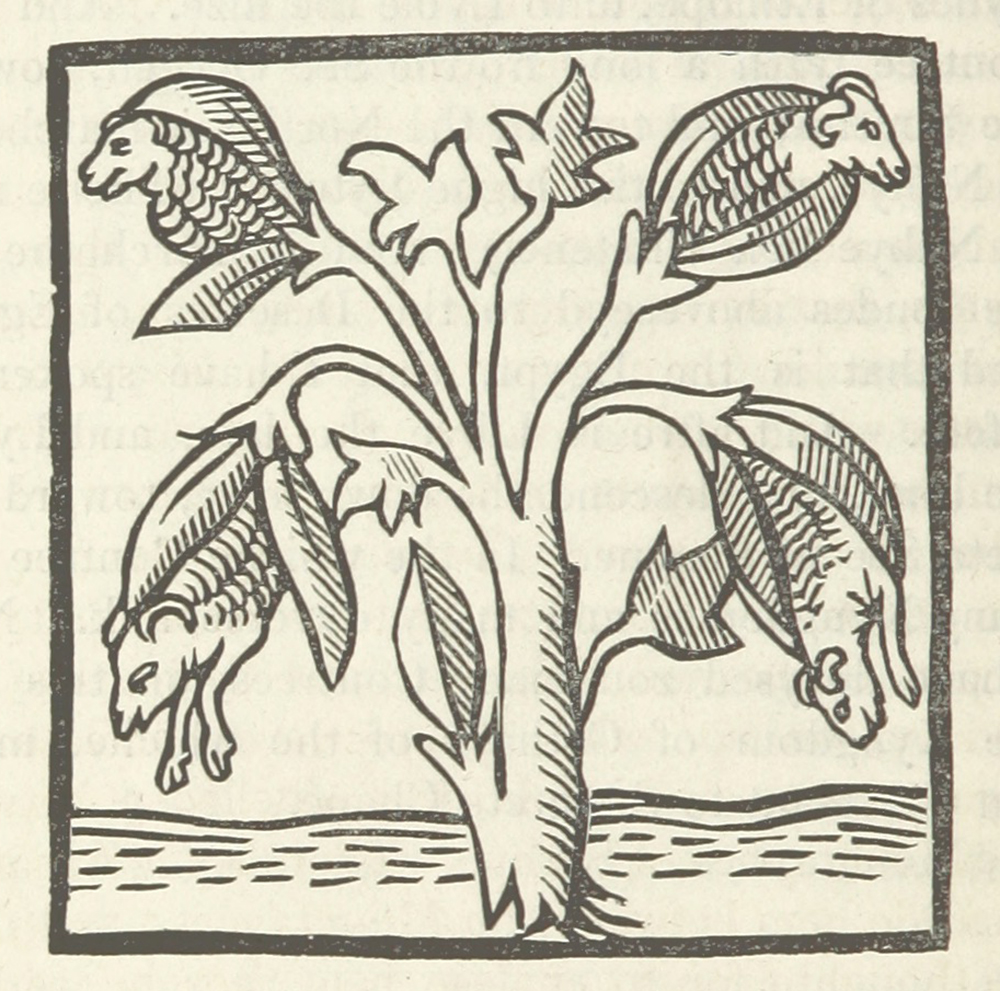
The most widely known European version of the Vegetable Lamb idea seems to have coalesced much later, in the medieval period, when it appeared in the Travels of John Mandeville, a fourteenth-century text detailing wonders observed across the Near East and North Africa. (There is a scholarly consensus that John Mandeville was a fictional protagonist around whom collections of travel stories—real or imagined—could be organized.) That book described a tree on which gourds grew; inside those gourds, delicious baby lambs wriggled. John Parkinson’s 1629 herbal Paradisi-in-sole Paradisus Terrestris includes the other commonly known description of the Lamb, a “Scythian Lamb” that grows from a stalk to which it remains attached, then dies after it has eaten all the grass in the surrounding area. Those are the prototypical physical forms of the Lamb: a creature that grows either inside a gourd or pod or atop the plant, as if the stalk were both umbilical cord and tether, keeping the creature bound throughout its life.
The most surprising feature of descriptions of the Lamb may be the absence of certain contemporary themes. Medieval and early modern commentators did not imagine the lamb as a kind of living horn of plenty or cornucopia. The lamb was not a parallel to the mythic land of Cockaigne, rich in fantastical foods, which starving peasants dreamed of reaching by eating their way through a wall of porridge. Nor did authors seem to connect it to biblical sources, as if to confirm the validity of biblical accounts of nature—a common practice for many Eastern wonders reported by Western travelers. Nor do any versions of the Lamb story speculate on what might be an obvious connection, namely between the Lamb and Christ as the “Lamb of God” and between the plant and the tree of the knowledge of good and evil in the Garden of Eden. Instead the Lamb seems to have been a mythic meditation on the compatibility of two forms of growth and life, that of plants and of animals.
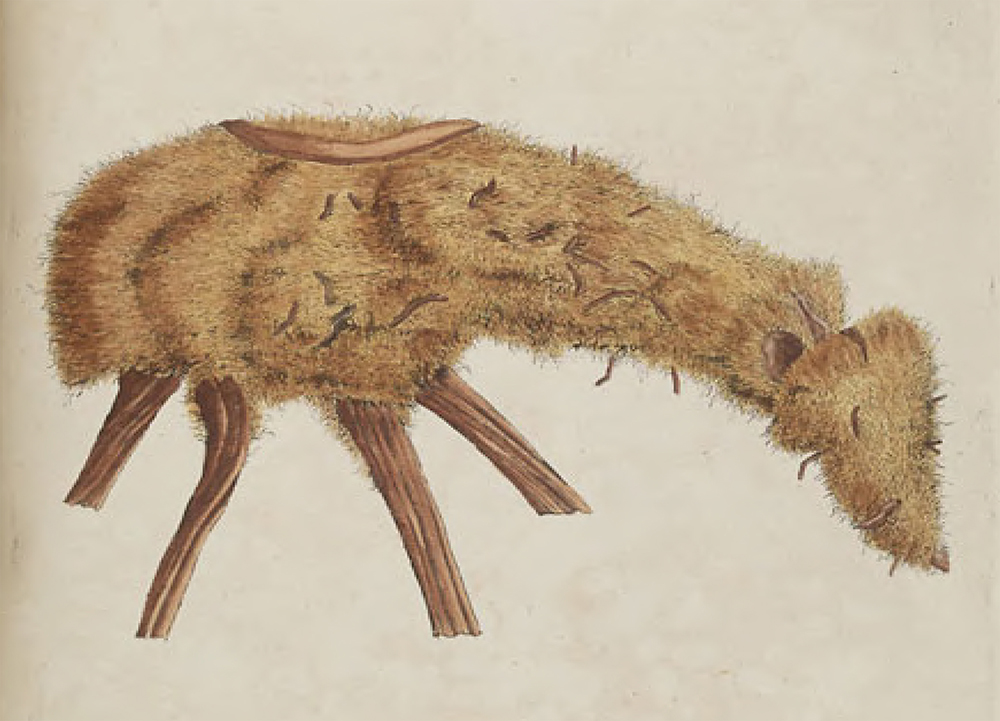
The seventeenth century saw a change in the Lamb’s fortunes, beginning with Francis Bacon’s 1627 Sylvia Sylvarum, in which the natural philosopher considered the legend more skeptically than its previous tellers. A chain of anecdotes had alerted other scholars to the Lamb’s existence. A robe putatively made from the Lamb’s wool was given to Richard Lee, former ambassador to the Russian court, according to Edward Smythe, who recorded the gift in a 1624 document. Whatever its real origins, the robe seems to have passed from Lee to the Bodleian Library before Smythe wrote his account. It was at the Bodleian at least as early as 1612, and the young Christopher Wren, later the architect of St. Paul’s Cathedral in London, observed it while a student. Smythe’s document eventually brought the Lamb to the attention of the Royal Society, in 1666. Its members considered whether it might be a “plant-animal,” or a zoophyte, but ultimately were no more willing to give credence to the Lamb than Bacon had been. Some decades thereafter, in 1712, the Lamb attracted additional critical attention in the writings of the German physician and traveler Engelbert Kaempfer—who thought the name borometz may have derived from Persian and Slavic words for sheep, barreh and baran—as well as those of the Scottish physician John Bell, who had visited Astrakhan to search for the Lamb only to be mocked by the natives for his interest. Hans Sloane—the collector, naturalist, and physician whose personal collections form the basis for important modern institutions such as the British Museum and London’s Natural History Museum—provided a detailed account of one specimen that he found in a cabinet of curiosities. He judged it to be part of a fern.
This was more than a Foot long, as big as one’s Wrist, having several Protruberances, and towards the end some Foot-stalks about Three or Four Inches long, exactly like to Foot-stalks of Ferns, both without and within. Most part of this was cover’d with a Down of a dark yellowish Snuff-Colour, shining like Silk.
Such descriptions make the “lamb” designation appear straightforwardly willful, even desperate. It is the imposition of an animal form, and imagined animal behavior, on what seems clearly to have been plant matter. Other observers of similar specimens corroborated Sloane’s impressions, noting cases in which some human hand had obviously jammed parts of the “lamb” into the proper shape to generate a quadruped appearance. Specimens of what was termed agnus scythius (Scythian Lamb) or agnus scythius borometz often arrived from China, where there was a separate vegetable lamb tradition: the mu-mien, or “mound-planted sheep,” whose inspiration may have been descriptions of the cotton plant in Chinese poetry circa 1000–1200. (Historians Karl A. Wittfogel and Fêng Chia-Shêng cite the I Wu Chi, written by Sung Ying probably between 265 and 420, under the Qin dynasty, as one early source of the mu-mien legend.) Sloane was among the commentators who judged such samples to be fern rhizomes, not lambs of any sort.
Others would return to the ancient Greeks by arguing that cotton was the original and most basic explanation for the lamb myth. One was the British naturalist Henry Lee, writing in the late nineteenth century. His The Vegetable Lamb of Tartary: A Curious Fable of the Cotton Plant claimed to offer the definitive explanation. “It seems to me clear and indisputable,” he wrote, “that the rumor referred to the cotton-pod, and originated in the first introduction of cotton and the fabrics woven from it into eastern Europe.” From John Mandeville’s account of a tiny lamb growing in a pod, Lee claimed, Europeans had progressed to the full-blown myth of a lamb growing from a stalk. Lee also reported that a contemporary of Mandeville’s, a monk from Friuli named Odoricus, had attested to the existence of Vegetable Lambs. Odoricus compared them to “barnacle geese” reported to grow on the shore of the Irish Sea, hatching from tree branches that extended over the water. He also reviewed early modern natural philosophers’ speculations that the “dense” (i.e., humid) air of Tartary might support zoophytes in a fashion that European climates could not. But ultimately Henry Lee turned back to Herodotus and credited cotton, not rhizomes, with the origin of the Lamb myth. Author of such works as Sea Monsters Unmasked and Sea Fables Explained, Lee rejected Sloane’s theory that fern rhizomes had generated the Vegetable Lamb myth, arguing that non-cotton specimens like Sloane’s had been “little lamblike toy figures ingeniously constructed by the Chinese.”
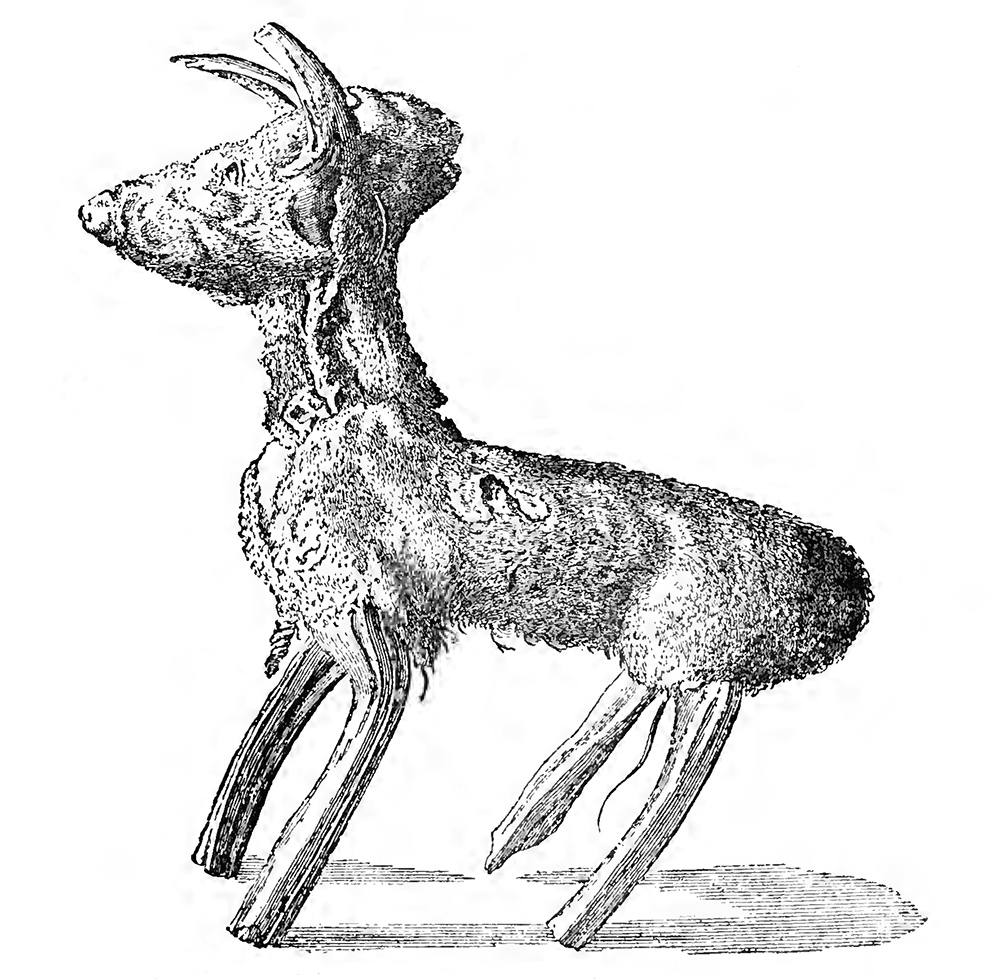
As Lee pointed out, the idea of a Vegetable Lamb could be derived from “the similarity of appearance of two actually different and incongruous objects.” The art historian James Elkins refines that issue of similarity by identifying visual analogy as a major ingredient in assembling the Vegetable Lamb. The stalk of the plant could be compared both to a plantlike stalk and to the umbilical cord of an animal. But could is too weak a word. The Lamb had to be understood by analogy to two presumably discrete natural categories—animal and plant—because a being that seemed to be neither was too wondrous. Analogy can serve as a stabilizing force, and in border cases like the borometz it supplies the conditions of possibility for explaining the Vegetable Lamb’s body as a body, rather than “matter out of place” (as the anthropologist Mary Douglas might put it), fleece emerging from a green stalk.
Elkins suggests that the governing framework for imagining the Lamb as a zoophyte was Platonic-Aristotelian, already old by the time of Mandeville’s travels and widespread in medieval and early modern thought: the Great Chain of Being, or scala naturae. This chain or scale stretched from the lowest worms to the highest angelic beings and even up to God. It can be understood as an answer to a question at once theological and cosmological: why would God create a universe of multiple goodnesses, manifest in a diverse creation, rather than allowing the universe to simply rest within God in perfect plenitude or, as Plato and Aristotle might have it, the Good? (Saint Augustine wrote, “Non essent omnia, si essent aequalia,” or “Nothing could be, if everything was the same”—in other words, diversity was a requirement for the existence of the universe.) The chain addressed this problem by positing a principle of gradual relation between all the elements of creation, combining plenitude and diversity. Humans usually were imagined somewhere in the middle. Aristotle saw plants, animals, and humans as having different kinds of souls, with those of plants being “nutritive,” consuming nourishment and growing and reproducing. Animal souls add to that list of traits the power of movement, and human souls add to the traits of animal souls the faculty of reason. Like begets like, so no discrete being could produce offspring unlike itself—though this is precisely what the Vegetable Lamb seems to do.
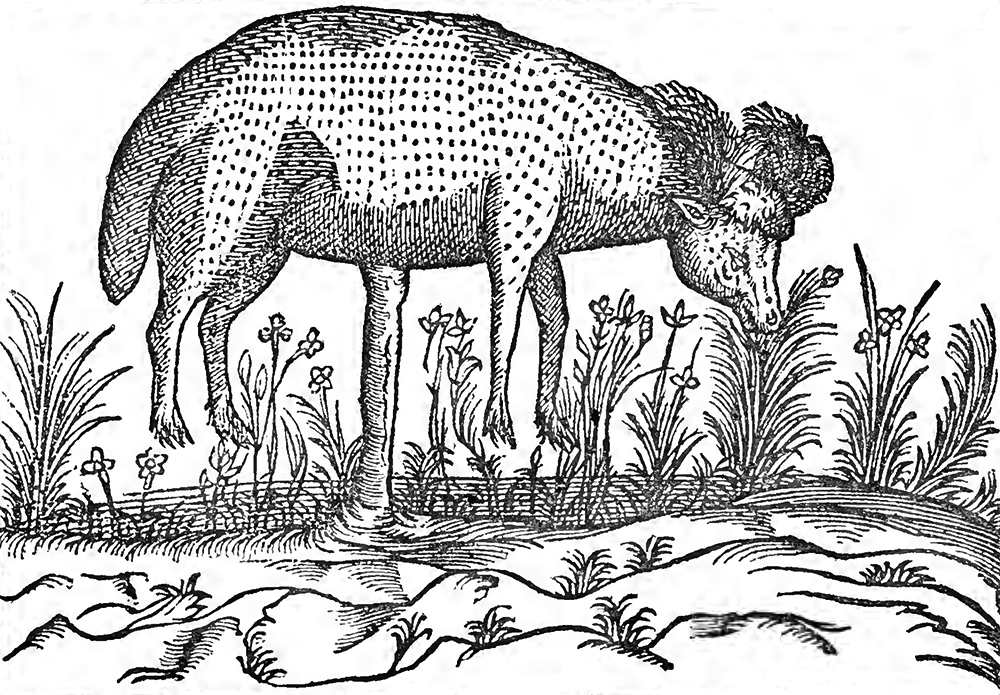
For Aristotle, analogy may be thought of as a kind of pattern recognition running across our experiences of disparate natural kinds. Thus, in his Posterior Analytics, he explains that we should identify a species by observing different individual beings and noting the properties they share and identify a genus by looking at groups of individuals of different species and determining their common traits. For Aristotle, analogy is what enables our identification of a common trait and the naming of a species or genus. Needless to say, the Vegetable Lamb would be a kingdom crosser, requiring such dramatic performances of analogy that it raises questions about the meaning of analogy itself (a topic with its own intellectual history). The Lamb seems to stand out as a kind of exception to the order of nature that by dint of being an exception confirms that nature. Despite the skepticism of seventeenth-century natural philosophers, the Lamb could return to inspire reflections on analogy in both poetics and science in the late eighteenth century.
Erasmus Darwin used the image of the Lamb in his well-known 1781 poem “The Botanic Garden,” which depicts a Lamb much like the one Sloane had described, though Darwin strangely locates it at one of the Earth’s poles:
E’en round the Pole the flames of love aspire,
And icy bosoms feel the secret fire,
Cradled in snow, and fanned by Arctic air,
Shines, gentle borometz, thy golden hair;
Rooted in earth, each cloven foot descends,
And round and round her flexile neck she bends,
Crops the gray coral moss, and hoary thyme,
Or laps with rosy tongue the melting rime;
Eyes with mute tenderness her distant dam,
And seems to bleat—a vegetable lamb.
For Darwin, the image of the Lamb may have served as an appealing illustration of how all life is derived from a common “filament,” the wellspring of all we might call “beings.” Such gestures, which seemed to blend scientific and literary impulses, would earn Erasmus the skeptical regard of his grandson Charles. But the simple operations of analogy, for Erasmus, implied an underlying unity of nature, as did the Aristotelian image of a Great Chain of Being. The irony is that Erasmus Darwin was keenly aware of the distinction between fanciful and insightful uses of analogy. He wrote:
But when with licentious activity [analogy] links together objects, otherwise discordant, by some fanciful similitude: it may indeed collect ornaments for wit and poetry, but philosophy and truth recoil from its combinations.
He thereby distinguished between what he usually called “rational analogy” and merely “witty” analogy. But the two dwell close together, as his inclusion of the Vegetable Lamb in his poem seems to suggest; the product of a “witty” analogy serves to remind us of what “rational analogy” had been seeking—a principle of underlying connection uniting all of creation. Erasmus Darwin’s later Temple of Nature (1794–96) employed the image of a “vital chain” linking all organic matter in an evolutionary process that ultimately yielded late eighteenth-century man.
In recent years, inspiration to rethink the relationship between animals and plants has sprung from life in the laboratory. Tissue culture techniques—first successfully used in 1907 by American embryologist Ross Harrison to keep animal cells alive in vitro—have led to over a hundred years of research primarily dedicated to furthering medical science. Since the turn of the twenty-first century, however, some scientists have pursued the cultivation of animal muscle tissue in vitro with the goal of growing meat. Such cells grow from a biopsy of muscle taken from a living animal. Though far from a seed in biological terms, the cells are fed growth media, and the ultimate product is harvested rather than slaughtered in the manner of a living animal. The line between plant and animal is crossed in new ways—not at the level of gross somatic elements as with the Vegetable Lamb but at the level of animal cells grown in a fashion analogous to plants.
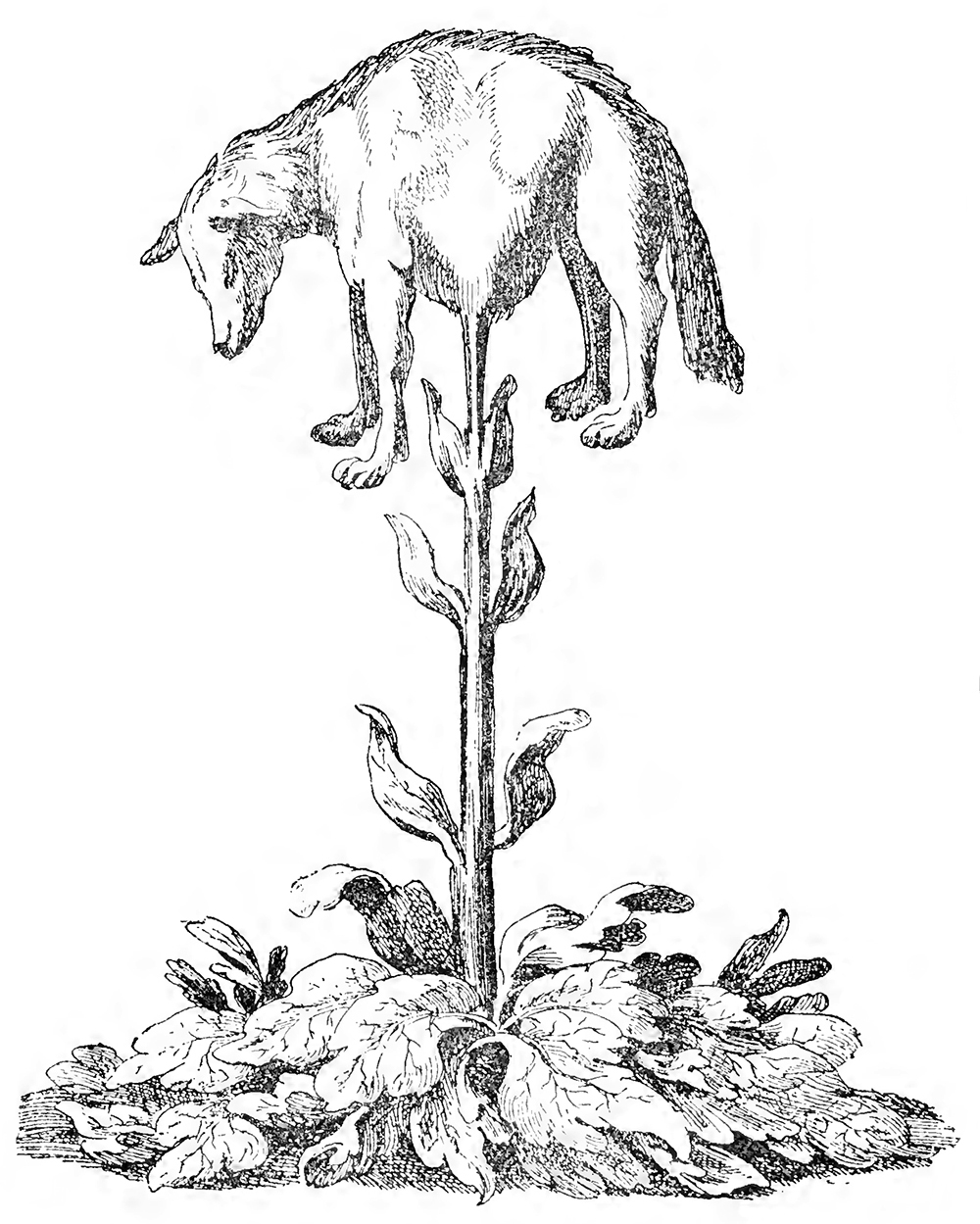
Like the Vegetable Lamb, cultured meat raises questions about how we recognize forms of life that do not slot easily into established categories. In this case, the issue is not how we see bodies but how we see animal life “de-animalized,” that is to say, without a body. Cells grown in vitro can be induced to display plasticity that they do not display in vivo. They can be made to live longer than they would ordinarily or to revert to the status of stem cells, which can then proliferate as different cell types. But of course cells grown in vitro have none of the relative autonomy we associate with the animals they come from. They are not even necessarily identical to cells of the same age that live as part of an animal, because an animal body and a cell-culture flask provide different environmental conditions, causing cells to modify their expression of traits.
We no longer think we live in a cosmos united by a Great Chain of Being. We still search for order (if not hierarchy), but we take pains not to presume its presence. And yet biotechnology reintroduces problems of categorization that once presented themselves to European travelers to distant lands and asks us if our terms of recognizing forms of life—by genetic information, by somatic organization, by autonomous individual or group behavior—are sufficient. The original story of the Vegetable Lamb depended on the idea that the teller of the tale and their audience had not seen all the marvels that exist, that unknown challenges would demand we employ allegory to recombine, and possibly rethink, the categories we use to understand the world. Even in the twenty-first century, the bleating of the Lamb reminds us that both biology and myth present us with important limit cases. The possibilities of life always extend past the range of our observation, and reach beyond analogy’s expectations for an orderly and predictable nature.
Sources
- Appleby, John H. “The Royal Society and the Tartar Lamb.” Notes and Records of the Royal Society of London 51, no. 1 (January 1997): 23–34.
- Berns, Andrew D. “The Place of Paradise in Renaissance Jewish Thought.” Journal of the History of Ideas 75, no. 3 (July 2014): 351–71.
- Carrubba, Robert. “Engelbert Kaempfer and the Myth of the Scythian Lamb.” Classical World 87, no. 1 (September–October 1993): 41–47.
- Chandra, Subhash. “Vascular Organization of the Rhizome of Cibotium barometz.” American Fern Journal 60, no. 2 (April–June 1970): 68–72.
- Darwin, Erasmus. Temple of Nature. London: Jones & Company, 1825.
- Elkins, James. “On Visual Desperation and the Bodies of Protozoa.” Representations 40, Special Issue: Seeing Science (Autumn 1992): 33–56.
- Griffiths, Devin S. “The Intuitions of Analogy in Erasmus Darwin’s Poetics.” Studies in English Literature, 1500–1900 51, no. 3 (Summer 2011): 645–65.
- Hesse, Mary. “Aristotle’s Logic of Analogy.” Philosophical Quarterly 15, no. 61 (October 1965): 328–40.
- Johnston, Mary. “Tree-Wool.” Classical Weekly 24, no. 8 (December 8, 1930): 63.
- Landecker, Hannah. Culturing Life: How Cells Became Technologies. Cambridge, MA: Harvard University Press, 2006.
- Lovejoy, Arthur. The Great Chain of Being: A Study in the History of an Idea. Cambridge, MA: Harvard University Press, 1936, 1971.
- Park, Katherine, and Lorraine Daston. Wonders and the Order of Nature, 1150–1750. Cambridge, MA: MIT Press, 1998.
- Tryon, Alice F. “The Vegetable Lamb of Tartary.” American Fern Journal 47, no. 1 (January–March 1957): 1–7.
- Whippo, Craig W., and Roger P. Hangarter. “The ‘Sensational’ Power of Movement in Plants: A Darwinian System for Studying the Evolution of Behavior.” American Journal of Botany 96, no. 12 (December 2009): 2115–27.
- Wittfogel, Karl A., and Fêng Chia-Shêng. History of Chinese Society: Liao, 907–1125. New York: American Philosophical Society, 1946.